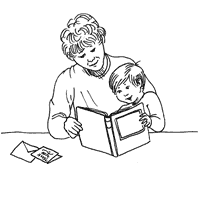STRANGE BUT TRUE- Random acts: Generosity promotes good health

DRAWING BY DEBORAH DERR McCLINTOCK
Q. Paying a compliment, telling a funny joke, sending a thank-you note, listening to someone attentively, donating to a hunger center, teaching a child to read, extending forgiveness to someone who has wronged you... What might all of these have to do with you own well-being?– M. Teresa
A. They're just a few of the myriad ways of "giving" to others, whether to family, friends, or the community. And giving is the most potent force on the planet, the one kind of love you can count on because you can always choose it, say Stephen Post and Jill Neimark in Why Good Things Happen to Good People. "Most of us can recall with radiant clarity those moments when giving was receiving, when another's happiness was our own," they write.
Now here's the remarkable part. Over 50 studies at 44 major universities funded by Case Western University Medical School have shown that generous behavior will reduce your risk of illness and mortality and that benevolent acts have a deep and lasting impact on your mental health, with these protections still intact decades later. Want more? Giving is also linked to traits of a successful life, e.g. social competence, empathy, tolerance, respect and positive emotion. "By learning to give, you become more effective at living itself," the report noted.
So, say the authors, "Give daily in small ways, and you will be happier, healthier, and even live longer."
Q. You know what you get when you milk a cow, but what about a horse? Which product is closer to Mom's own? –R. Rogers
A. Mare's milk is lighter and sweeter than cow's milk, with notes of watermelon and wild grass and a nutty undertone, says New Scientist magazine. Fact is, it was popular in Europe early last century, so much so that in Germany it was delivered door to door and is making a comeback today in Belgium, France, and Norway. While mostly sold as a freeze-dried powder, mare's milk can be found fresh in various Parisian outlets.
But it's not cheap– 12 euros ($16.50) for a quarter liter. It has been touted as a health elixir of sorts, and for one group this certainly seems true: infants with severe food allergies will often tolerate mare's milk better than other types. In central Asia, mare's milk is a staple– especially with a kick. In Mongolia and elsewhere, the tradition is to ferment it in a horsehide sack until it turns into a frothy alcoholic drink.
Q. "Hey sweetie, look into my true blue eyes and tell me something about them I don't already know. If you only have eyes for me, are you up to the challenge?" –F. Sinatra
A. "Up and more, my love, for I see by your dilated pupils and rapid blinking that you're emotionally supercharged, which I trust is in my favor. Our eyes evolved as billboards to communicate emotion, and yours are doing so in bold letters. As to your fetching blues, what appears to be a uniform iris is actually a kaleidoscope of hues, iridescent and intricately patterned.
"The human eye works in mysterious ways, as I know from Simon Ings' book, The Eye: A Natural History. We spend much of our waking hours functionally 'blind' in that our eyes move about three times per second, forcing the brain to ignore visual signals to save us from perpetual seasickness. That's about 10 percent of seeing time eclipsed; for the rest, we focus on only 1 percent of what's around us. Moreover, whatever we do see is already in the past, since there's roughly a half-second delay from an image registering on the retina to our becoming aware of it. In truth, eye-weirdness begins even before birth, when the not-pitch-blackness of the womb aids our development of nocturnal vision. Then at birth, we can barely see in daylight.
"I see now by your shining orbs that I have met your challenge and hope for more such shining moments to come."
Q. A psychology student twists Shakespeare's "All the world's a stage" into "All the world's a Rorschach." She says she's serious. Is she on to something? –B. Jonson
A. People surely perceive what they want to, whether they're reading patterns in inkblots, seeing "the man in the moon," or hearing messages in shower spray hitting against the curtain, says Leonard George in Alternative Realities. Some years ago, a New Mexico woman scorched a tortilla and read in the charred pattern an image of Christ's head amid thorns, with thousands of believers making a pilgrimage to see it with their own eyes. Film producer Frederick Jurgenson once said he heard faint mumbles in his recordings of bird songs and believed these were voices of departed spirits.
When there's "backmasking": Following the suicide of a fan of the rock group Judas Priest, the rumor spread that the phrase "Do it!" was recorded backward in their music, says John Dworetzky in Psychology. The band was brought to trial. The judge could clearly hear "Do it," but sound technicians demonstrated that the phrase was really just word parts combined with the sound of one of the guitars.
"I've had similar experiences," says Dworetzky, who recalls frequenting an Armenian restaurant with friends, and though none of them knew the language, soon recognizable phrases began cropping up in the songs– English phrases! In one song, the silly phrase "Scotch tape on a boa" kept coming up. New friends joining them thought this was crazy, until they too were cued in to listen for it at just the right moment. Then they couldn't stop hearing it.
Rorschach with a vengeance.
Send Strange questions to brothers Bill and Rich at [email protected].
#